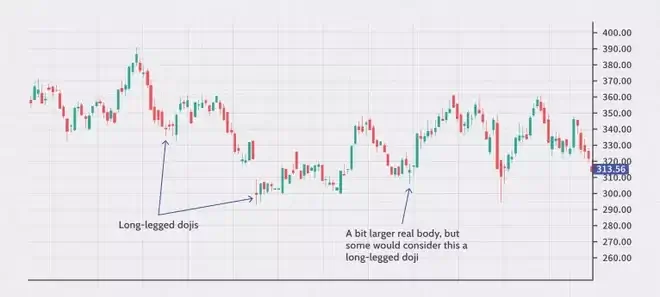Long-Legged Doji Candlestick: What does it mean?

Long-Legged Doji Candlestick: What does it mean?
Technical analysis represents an essential aspect of trading in financial markets. Therefore, knowing to read and implement the long legged Doji candlestick in your trading strategy should be the priority of every professional trader. If you are unsure what long legged Doji candlestick represents and the Doji candle pattern in general, we will explain it in the following lines.
What is a Doji Candlestick Pattern?

A Doji is a traditional chart pattern that looks like a cross or plus sign and occurs when the open and close prices of a candle are very close or equal. Doji candles are interpreted as a sign of indecision in the market. Meaning “blunder” in Japanese, the term Doji was first used by Japanese commodity traders to describe the rare occurrence of a candle with precisely the same opening and closing.
Originating in Japan, candlestick charting was invented by legendary Japanese rice futures trader Homma Muneisha. Doji candles are often considered necessary by technical analysis traders. Although a Doji may not mean much in a trendless market, the appearance of a Doji candle in a trending market can be an essential event, primarily to identify trend reversals. Primarily used in daily charts, Doji candlesticks can be spotted in any chart interval and across all timeframes.
Types of Doji Patterns
For all Doji candles, the open and close prices are practically equal. However, small intricacies make four distinct types of Doji.
Neutral Doji: This form of the Doji occurs when the open/close price falls in the middle of the high and low prices for the selected period. Outside a trending market, dojis are often seen as neutral patterns by technical analysts.
Long Legged Doji Candlestick: An extended version of the Neutral Doji, in the candlesticks analysis, a long-legged Doji indicates increased indecision regarding future market price.
Dragonfly Doji: The opposite of a gravestone Doji, when the opening and close of a bar occurs at or above a bar, we have a Dragonfly Doji. Traders search for Dragonfly Dojis to help determine the top of an uptrend and spot bearish reversals.
Gravestone Doji: Once the open and close of a bar falls at or very close to the bottom of the bar, we have Gravestone Doji formation. It can sometimes indicate a bullish reversal of a downtrend.
Long legged Doji candlestick meaning

The long legged Doji is a candle that has a lot of significance in tops and bottoms and can mark a change in trend if confirmed with the next candle. Therefore, a candle can be bullish or bearish, depending on where it occurs. Being a Doji, it reflects indecision and equality of upward and downward strength, leaving the close at the same level as the open, but after the price has oscillated a lot and there has been significant volatility, hence the long upper and lower shadows.
It has greater predictive power than the high wave candle, although it is similar in its formation and effects. In downtrends, the long-legged doji candlestick marks the trend change to the upside if the next candle closes above the previous close and preferably if it is a large white candle that has gapped higher. In uptrends, this long legged Doji candle will mark a trend change to bearish if the next candle has a lower close than the previous one and preferably if it is a large black candle with a gapped open lower.
Understanding the Long Legged Doji Candlestick
A long-legged Doji means indifference about the future price direction of the underlying security. Long-legged Doji can also mark the beginning of a consolidation period when the price of one or more long-legged dojis forms before entering a tighter pattern or breaking out to create a new trend.
Long-legged Doji candles are considered very noticeable during a strong uptrend or downtrend. The long legged doji suggests that the forces of supply and demand are nearly in balance, and a trend reversal could occur. It happens because a balance or a disqualification means that the price is not pushing in the direction it was before. Sent may be changing.
For example, the price is rising, and at the end of most periods is above the open. The long-legged doji shows that there was a battle between buyers and sellers.
The pattern can be found on any timeframe but is more important on longer-term charts, as more participants contribute to its formation. It is part of the larger doji family consisting of the standard doji, dragonfly doji, and tombstone doji.
How to trade using Long Legged Doji Candlestick
There are several ways to trade a long-legged doji, although pattern-based trading is unnecessary. According to some traders, the pattern is just a candle, which is not significant enough, especially since the price did not move much on a final basis, to make a trading decision.
Some traders will want to see more safety, the price movements that occur after the long-legged doji, before acting. This happens because long-legged dojis are sometimes grouped together or as part of a larger consolidation. These consolidations could lead to a reversal of the previous trend, or a continuation, depending on how the price breaks out of the consolidation.
If you want to trade the pattern, here are some general trading ideas:
Enter: Since the pattern is considered an unspecified period, a trader can wait for the price to move above the high or low of the long-legged doji. If the price moves up, enter a long position. If the price moves below the pattern, enter a short position. Alternatively, wait to see if condensation forms around the long-legged doji and then go long or short when the price moves above or below the condensate, respectively.
Risk management: If you enter whenever the price moves above the long-term doji or consolidation, place a stop loss below the pattern or consolidation. Conversely, if you go short when the price moves below the doji or long-term consolidation, place a stop loss above the pattern or consolidation.
Market Structure: The long-legged doji is more likely to give a valid signal if it is seen near a considerable support or resistance level. For example, if the price is rising and a long-legged doji forms near a significant resistance level, this can increase the chances of a downside if the price falls below the low of the low-legged doji.
Profit Making: Long-legged doji candlestick doesn’t have profit targets, so traders will need to find a way to make a profit if they exist. Traders could use technical indicators or exit when the price crosses a moving average, for example. Some traders may use a fixed risk/reward ratio. For example, if they risk a $200 trade, they abandon the trade when it exceeds $400 or $600.
Why integrate long legged doji candlestick into your trading strategy?
Long legged doji candlesticks are an important tool that can convey important information regarding the psychology of investors present in the market. However, in the world of trading, no single indicator is enough to trade.
To minimize the false signals you may encounter, it is necessary to use several tools simultaneously and collect as much data as possible simultaneously. As a result, long legged doji candlestick proves its effectiveness when used with other tools such as Bollinger bands (volatility indicators).
Long legged Doji candlestick – key takeaways
- The long-legged doji is a candlestick made up of long upper and lower shadows and has the same open and close price.
- The pattern shows indifference and is most noticeable after a strong progression or decline.
- While some traders may act on the no-candlestick pattern, others want to see what price does after the long-legged Doji.
- The pattern is not always significant and will not always mark the end of a trend; it may mark the beginning of a period of consolidation or an insignificant glimmer in the current trend.
Conclusion
Although their origin dates back to the 17th century, Japanese candles are still relevant today. The first version of Japanese candles was adapted for technical analysis by American Charles Dow in 1900.
As we have seen throughout this article, long legged doji candlesticks are a tool that can make trading the forex markets much easier.
In general, the curves of Japanese candlesticks represent a comfortable way for daily market analysis by traders. As a result, forex traders who work on learning and improving the reading of Japanese candlestick long legged doji, develop in parallel a clear vision of the forex market fluctuations and the direction and the trend adopted.
In fact, forex experts go so far as to claim that Japanese candlesticks can be virtually self-sufficient tools if interpreted in the right way.
The purpose of long legged doji candlestick is very simple. It is to know the element that dominates the evolution of prices between the buying and selling parties at a given moment to obtain the information before the others and to take advantage of advances in trading operations.
Also, keep in mind that we find the use of long legged doji candlestick on the forex market but also in the cryptocurrency and commodity markets.
The post Long-Legged Doji Candlestick: What does it mean? appeared first on FinanceBrokerage.


0 Response to "Long-Legged Doji Candlestick: What does it mean?"
Post a Comment